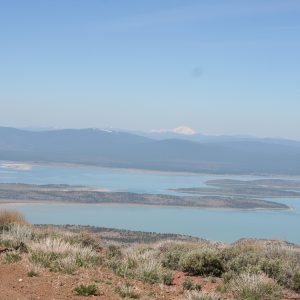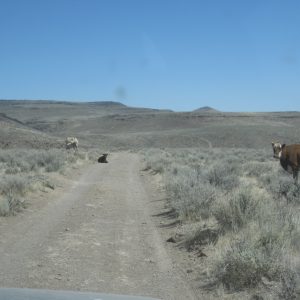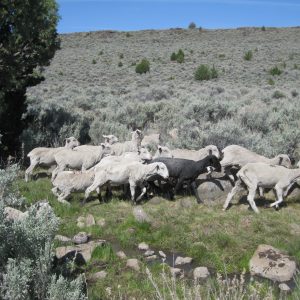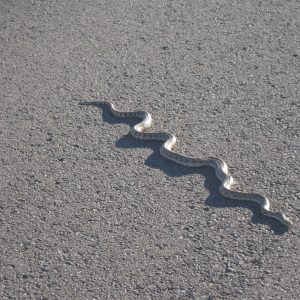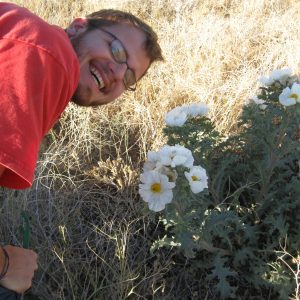In addition to the valuable career experience gained through the Chicago Botanic Garden’s Conservation and Land Management (CLM) Internship program, there are plenty of good times to be had as a CLM intern! When working on public lands, it’s important to be on guard; one can never fully anticipate the plethora of dangers that could be lurking in the grass, underneath a shrub, behind a tree, or ANYwhere!
RATTLESNAKE. A few months ago, I encountered my first rattlesnake in the wild! I was so excited (especially because I wasn’t under immediate danger as it was about 10 feet away)! Another intern and I heard it rattling behind us then turned to see it’s rattle-tipped tail slithering from the dirt path into the golden-brown grasses and forbs. I really wanted to get an awesome photo…but I also did not want to end up in a hospital that day so I kept my distance and took the best shots I could get using the zoom.

Can you see the rattle?!

Rattlesnake in its liar under that rock outcropping
DEVIL’S CLAW. Now what kind of plant is this!? I came across it on the border of public land and someone’s backyard. Lovely flowers but oofta! It’s odor is definitely not one to market as a perfume fragrance. The big green pod-like fruits are coated with a stinky wet substance…and the dry skeleton of these fruits–vicious-looking! These are some serious hitchhikers–watch out. But, on a lighter note, they make for a great jack-o-lantern moustache. 🙂

Devilish fruit with semi-slimy, odorous fleshy coat surrounding a sharp-pointed wood-like capsule

As good as they are at hitchhiking, Devil's claws make pretty good moustaches.
THE CHAPARRAL CRAWL. Many of the plant species composing the chaparral plant community are intriguing, eye-catching, hardy, rare, or any combination of these. Throughout the changing colors of the seasons, the beautiful vegetation attacks nature-observers, photographers, and hikers. And it is lovely to hike through the chaparral…as long as there is a wide path. The dense shrub layer of the chaparral adds an interesting challenge to botanical work; it’s nothing like walking through grassland or under the canopy of a forest. To get through the seemingly impenetrable sea of whiteleaf manzanita (Arctostaphylos viscida) and chamise (Adenostoma fasciculatum), one has to either do some bushwhacking (but with care to minimize damage, especially near rare plant populations) or learn how to do the chaparral crawl (described so eloquently by my partner in crime in a previous blog post “Chaparral”). I’ve come to the conclusion that no matter how much one has performed the Chaparral Crawl obstacle course, it will always be awkward and lacking grace. Not recommended for anyone suffering from claustrophobia, lack of sleep, or a bad day as performing this task has the tendency to exacerbate irritation and frustration levels. For those brave enough to ever attempt the chaparral crawl (I’m pretty sure this would only include individuals whose job requires it, volunteers who think participating in a plant survey sounds exciting, adventurers who just have to try it for the experience, and extreme geocachers), be sure to wear thick pants (else they’ll tear), a long-sleeve shirt (even thick flannel has been torn by the woody weaponry of the chaparral shrubbery), a cap or hat (prevent the entanglement of hair on branches…also a reason to tuck shoelaces into your shoes), and eye protection (yes, branches do snap back). And, of course, always be on your guard for poison oak among the shrub ranks and don’t forget to check for ticks after crossing the finish line.

Can you see the Chaparral Crawl participant in this photo?

On this particular day, my pants did not survive the chaparral unscathed
DEFENSIVE DRIVING. Assuming the average CLM intern has been driving for at least a few years by the time they begin their internship position, it may be that some, maybe many, don’t pay that close attention to the defensive driving training. The key is to remember it is just as much about awareness of other drivers in other vehicles as it is about you in a government vehicle. Here’s an example: this “truck” appears to have been put together by students in a high school shop class using pieces of various vehicles left in a junkyard. Besides lacking doors, the body of the “truck” was not centered on the axles, on which it appeared to be resting or tied together with a few pieces of wire rather than bolted together; thus, whenever this so-called truck took a curve, we slowed down (defensive driving!), bracing for it to tip on its side. Because it eventually turned onto a side road, we can only assume this vehicle succeeded in transporting the driver and passenger safely to their destination.

Appears to be dangerous...are vehicles like this even legal?

I would not trust that truck to not tip over!









